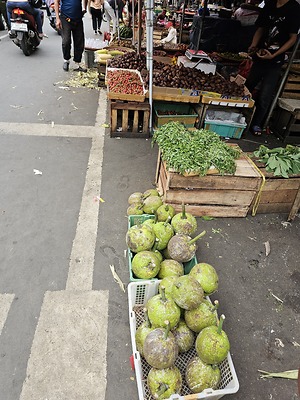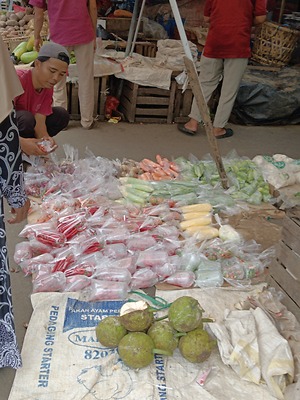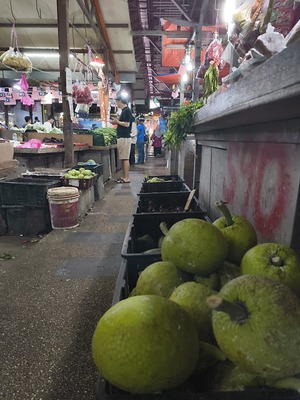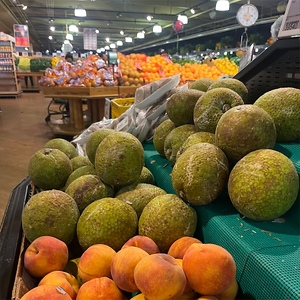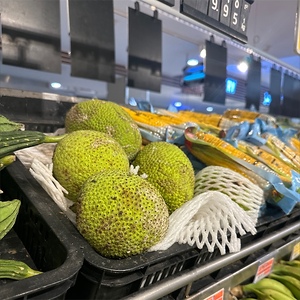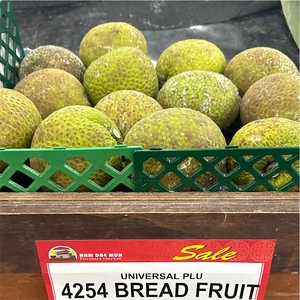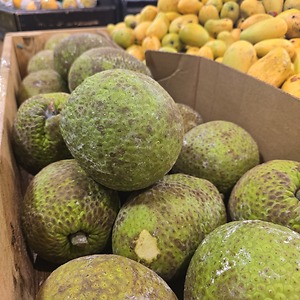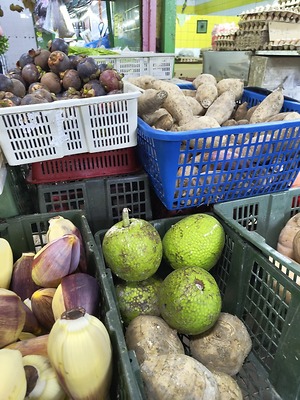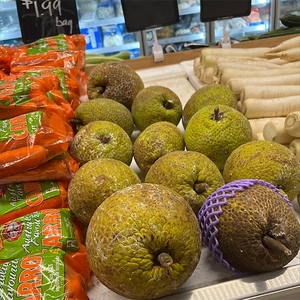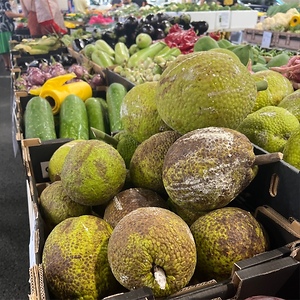

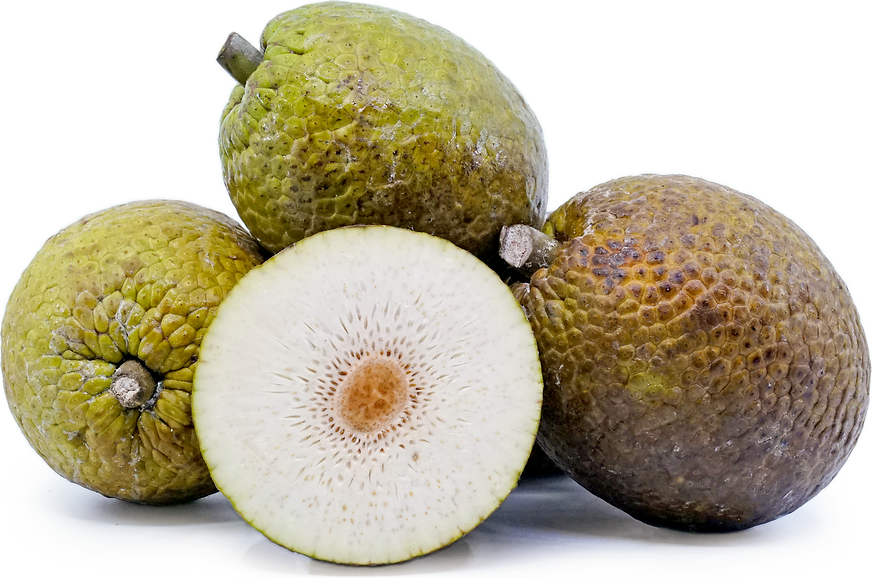
Breadfruit
Estimated Inventory, lb : 0
This item was last sold on : 09/02/24
Description/Taste
Breadfruit is a medium to large-sized fruit, averaging 10 to 30 centimeters in diameter and 3 to 5 kilograms in weight, and has a round, oval, to oblong shape. The fruit's appearance will vary depending on the specific variety and growing conditions. The rind is thin, covered in small, segmented faces resembling 4 to 6-sided nodes that have fused together. The surface can be semi-smooth, pebbled, rough, or sharp, sometimes bearing green spines or black points in the center of each face. The rind also changes from green when unripe to shades of yellow and yellow-brown when mature. It is important to note that the fruits, stems, and other parts of the tree often contain white, gummy latex that may irritate the skin if contact occurs. Young Breadfruits have a solid, dense, fibrous, and starchy white flesh. As the fruits ripen, the flesh transitions into a pale-yellow hue and softens, developing a sticky and creamy consistency. Breadfruit can be seedless or contain oval brown seeds reaching 2 to 3 centimeters in length that are typically rounded at one end and pointed at the other. There is also an unusual, spongy core encasing the seeds that should be removed prior to eating the fruits. Breadfruit can only be consumed raw when the fruits are mature and have a soft texture. The fruits are primarily cooked before consumption and release a sweet and fragrant aroma reminiscent of freshly baked bread, earning them their bread-based moniker. Cooked young Breadfruit has a vegetal, green flavor similar to artichoke, while mature Breadfruit has a mild and subtly sweet, potato-like taste.
Seasons/Availability
Breadfruit is available year-round in tropical climates.
Current Facts
Breadfruit, botanically classified as Artocarpus altilis, is a tropical species belonging to the Moraceae family. The fruits grow on large, fast-growing trees, reaching 12 to 26 meters in height, and are one of the tallest fruit-producing trees in existence. A single Breadfruit tree matures in 3 to 5 years and can grow 50 to 200 fruits annually, often equating to 204 kilograms of edible flesh used as a food source among communities worldwide. Breadfruit is an ancient crop that has been domesticated over time to create hundreds of varieties grown throughout the tropics. The species is favored for its edible fruits traditionally prepared like starches, providing a nutrient-dense meal with satiating properties. Worldwide, Breadfruit is known by many names, including Fruta de Pan in Spanish, Sa-Ke in Thailand, Ulu and Tree potato in Hawaii, Suku or Sukun in Malaysia, Rimas in the Philippines, Panapen in Puerto Rico, Pan de Ano in Venezuela, Mazapan in Guatemala, Arbor de Pan in French, and Pao de Massa or Fruta Pao in Portuguese. In the modern day, scientists are extensively studying Breadfruit as a nutritious food source to reduce starvation. Breadfruit trees will produce edible fruits for decades, and the fruits are traditionally cooked in a wide array of sweet and savory preparations. The trees are also used for their leaves in natural medicines, wood as construction material for furniture, surfboards, and canoes, latex sap as a water sealant, and bark as a natural cloth.
Nutritional Value
Breadfruit is a source of antioxidants to protect the cells from oxidative stress and damage caused by free radicals and contains complex carbs and complete protein, meaning it has all nine essential amino acids. The flesh is also gluten-free and provides vitamin C to strengthen the immune system, calcium to build strong bones and teeth, potassium to balance fluid levels within the body, fiber to regulate the digestive tract, and other nutrients, including iron, B vitamins, niacin, phosphorus, vitamin A, and magnesium. In the Caribbean, Breadfruit leaves are incorporated into natural remedies to reduce spleen swelling, lower blood pressure, and soothe the digestive tract. The leaves are also burned into ash and applied topically to calm skin infections
Applications
Breadfruit can be consumed raw when ripe, but the flesh is primarily cooked to develop a richer flavor and softer consistency. In cooked preparations, Breadfruit can be used at any stage of maturity and is traditionally peeled, sliced into sections, cored, and prepared similarly to starches. The flesh can be boiled or steamed and added to pasta salads, mashed with coconut milk or garlic and oil as a side dish, incorporated into pancake batter, or stirred into dips. Breadfruit can also be boiled and diced into a ceviche-like dish known as poisson cru in Tahiti, baked and sliced into chips, cooked into a variation of French fries, added to curries, soups, and stews, or incorporated into casseroles, burritos, rice-based dishes, and falafel. Try baking, dicing, and stuffing small pieces of Breadfruit into egg rolls, wontons, and lumpia, or boiling the flesh, mixing it with coconut oil, and using it like dough for tamales or pizza. In Malaysia, Breadfruit is dipped in batter and fried, served as an afternoon snack with tea. In Guam, the flesh is cooked, mashed into a paste, spread thinly, and dried in the sun to make fruit leather. This chewy dish is traditionally wrapped in leaves for extended storage and will last for several months to years, depending on the preparation method. Beyond savory preparations, Breadfruit can be added to cake, pie, pudding, and malasada recipes, frozen into ice cream, or cooked and combined with a mixture of sugar cane, coconut milk, and condensed milk. Breadfruit pairs well with fruits such as coconut, kiwi, starfruits, bananas, apples, and passion fruit, aromatics including ginger, garlic, onions, and shallots, and spices such as turmeric, coriander, cumin, and smoked paprika. Whole, unopened Breadfruit should be immediately consumed when ripe for the best quality and flavor. The fruits have a short shelf life and will keep for a few days in a cool, dark place. Once mature, Breadfruit can be stored in the refrigerator for a day or two to extend its shelf life.
Ethnic/Cultural Info
Breadfruit was the catalyst for the infamous mutiny on the HMS Bounty. In 1787, William Bligh was appointed captain of the HMS Bounty by the British crown to gather Breadfruit trees for planting on sugar plantations in the British West Indies. During this time, the American Revolution prevented fewer ships from the American colonies from traveling and supplying the West Indies with resources. In an effort to find an alternative solution, Breadfruit was recommended by Sir Joseph Banks, a naturalist who traveled with Captain James Cook, for its potential as a cheap, high-energy, nutritious food crop. Banks had encountered Breadfruit trees on his journey with Cook and convinced King George III that the trees would be an ideal food for slaves. King George III quickly approved the idea and instructed Bligh and his crew to transport over 1,000 Breadfruit trees from Tahiti to the Caribbean. It took the HMS Bounty over ten months to sail to Tahiti, and the ship's late arrival pushed their final journey to the West Indies back by five months. When the time finally arrived for the Breadfruit trees to be transported to the West Indies in 1789, many of the HMS Bounty crew members had grown fond of their life in Tahiti and did not want to make the journey. The crewmembers were forced onto the ship, around 46 in total, and Captain Bligh was disgusted by their lack of discipline leading him to punish the crew, especially Fletcher Christian, the master's mate, creating tension aboard the Bounty. It is unknown what was the actual cause of the mutiny, but Christian led a rebellion against Bligh, causing the crew to split and take sides. The mutineers forced Bligh and 18 other crewmembers on a boat with a sextant and a few rations, and the Breadfruit trees were hurled overboard into the ocean. Despite the shock of the mutiny, Bligh survived and navigated approximately 3,618 miles over 47 days to land at the Dutch settlement in Timor. In 1791, Bligh eventually led a second journey on the HMS Providence to introduce 1,177 Breadfruit trees to the West Indies. The trees were planted in Jamaica and St. Vincent in 1793, and it is rumored that one of the Breadfruit trees planted from Bligh's trip on the island of Jamaica is still alive.
Geography/History
Breadfruit is thought to be native to regions of the Malay Archipelago and the South Pacific, growing wild since ancient times. Over 3,000 years ago, indigenous people groups began selecting their preferred varieties, breeding and domesticating the fruits to develop improved cultivars for culinary, medicinal, and cultural uses. Polynesians are credited with introducing Breadfruit to the Hawaiian Islands, and the fruits were one of the famous canoe plants carried with the voyagers in their canoes to colonize their new home. Once the Polynesians reached Hawaii, they planted the Breadfruit seeds, creating expansive plantations. Some historians believe that the Breadfruit groves were so large in Hawaii that they, at one time, could feed over 75,000 people. Presently in Hawaii, the National Tropical Botanical Garden has a Breadfruit Institute, an organization that studies and preserves one of the largest Breadfruit collections in the world. In 1595, Europeans encountered Breadfruit in the Marquesas for the first time, and by the 18th century, British explorers were carrying Breadfruit trees on their ships to plant in the Caribbean. Spanish explorers were also introducing Breadfruit to regions of the New World, sourcing trees from the Philippines and growing them in Central America and Mexico. In 1906, the United States Department of Agriculture brought Breadfruit plants from Panama and planted them in Florida, but only a few trees survived. Today Breadfruit thrives in mainly tropical to subtropical climates and is sold through select markets, grocers, and distributors worldwide.
Recipe Ideas
Recipes that include Breadfruit. One



